Progressive Gaussian Decomposition of Airborne Bathymetric LiDAR Waveform for Improving Seafloor Point Extraction
Abstract
:1. Introduction
- Decompose ABL waveforms of various types and shapes;
- Improve the extractability of seafloor points by detecting elusive seafloor signals.
2. Materials
2.1. Seahawk System
2.2. Test Data
3. Methods
3.1. Noise Removal and Signal Range Selection
3.2. Progressive Gaussian Decomposition
4. Results
4.1. Fitness Evaluation
4.2. Point Extractability Evaluation
4.3. Geolocation Accuracy Assessment
5. Discussion
6. Conclusions
Author Contributions
Funding
Institutional Review Board Statement
Informed Consent Statement
Data Availability Statement
Conflicts of Interest
References
- Klemas, V. Beach profiling and LIDAR bathymetry: An overview with case studies. J. Coast. Res. 2011, 27, 1019–1028. [Google Scholar] [CrossRef]
- Neal, J.; Hawker, L.; Savage, J.; Durand, M.; Bates, P.; Sampson, C. Estimating river channel bathymetry in large scale flood inundation models. Water Resour. Res. 2021, 57, e2020WR028301. [Google Scholar] [CrossRef]
- Wang, C.; Li, Q.; Liu, Y.; Wu, G.; Liu, P.; Ding, X. A comparison of waveform processing algorithms for single-wavelength LiDAR bathymetry. ISPRS J. Photogramm. Remote Sens. 2015, 101, 22–35. [Google Scholar] [CrossRef]
- Guenther, G.C. Airborne lidar bathymetry. In Digital Elevation Model Technologies and Applications: The Dem Users Manual, 2nd ed.; Maune, D.F., Ed.; ASPRS Publications: Bethesda, MD, USA, 2007; pp. 253–320. [Google Scholar]
- Hilldale, R.C.; Raff, D. Assessing the ability of airborne LiDAR to map river bathymetry. Earth Surf. Process. Landf. 2008, 33, 773–783. [Google Scholar] [CrossRef]
- Ducic, V.; Hollaus, M.; Ullrich, A.; Wagner, W.; Melzer, T. 3D vegetation mapping and classification using full-waveform laser scanning. In Proceedings of the Workshop on 3D Remote Sensing in Forestry, Vienna, Austria, 14–15 February 2006. [Google Scholar]
- Reitberger, J.; Schnörr, C.; Heurich, M.; Krzystek, P.; Stilla, U. Towards 3D mapping of forests: A comparative study with first/last pulse and full waveform LIDAR data. In Proceedings of the International Archives of Photogrammetry, Remote Sensing and Spatial Information Sciences, Beijing, China, 3–11 July 2008. [Google Scholar]
- Letard, M.; Collin, A.; Lague, D.; Corpetti, T.; Pastol, Y.; Ekelund, A.; Pergent, G.; Costa, S. Towards 3D mapping of seagrass meadows with topo-bathymetric lidar full waveform processing. In Proceedings of the 2021 IEEE International Geoscience and Remote Sensing Symposium IGARSS, Brussels, Belgium, 11–16 July 2021. [Google Scholar]
- Long, B.; Cottin, A.; Collin, A. What Optech’s bathymetric LiDAR sees underwater. In Proceedings of the 2007 IEEE International Geoscience and Remote Sensing Symposium IGARSS, Barcelona, Spain, 23–28 July 2007. [Google Scholar]
- Zhao, X.; Zhao, J.; Zhang, H.; Zhou, F. Remote sensing of suspended sediment concentrations based on the waveform decomposition of airborne LiDAR bathymetry. Remote Sens. 2018, 10, 247. [Google Scholar] [CrossRef]
- Richter, K.; Maas, H.G.; Westfeld, P.; Weiß, R. An approach to determining turbidity and correcting for signal attenuation in airborne lidar bathymetry. PFG—J. Photogramm. Remote Sens. Geoinf. Sci. 2017, 85, 31–40. [Google Scholar] [CrossRef]
- Wagner, W.; Ullrich, A.; Melzer, T.; Briese, C.; Kraus, K. From single-pulse to full-waveform airborne laser scanners: Potential and practical challenges. In Proceedings of the International Archives of Photogrammetry, Remote Sensing and Spatial Information Sciences, Istanbul, Turkey, 12–23 July 2004. [Google Scholar]
- Roncat, A.; Wagner, W.; Melzer, T.; Ullrich, A. Echo detection and localization in full-waveform airborne laser scanner data using the averaged square difference function estimator. Photogramm. J. Finl. 2008, 21, 62–75. [Google Scholar]
- Abdallah, H.; Bailly, J.S.; Baghdadi, N.N.; Saint-Geours, N.; Fabre, F. Potential of space-borne LiDAR sensors for global bathymetry in coastal and inland waters. IEEE J. Sel. Top. Appl. Earth Obs. Remote Sens. 2012, 6, 202–216. [Google Scholar] [CrossRef]
- Abady, L.; Bailly, J.S.; Baghdadi, N.; Pastol, Y.; Abdallah, H. Assessment of quadrilateral fitting of the water column contribution in lidar waveforms on bathymetry estimates. IEEE Trans. Geosci. Remote Sens. 2013, 11, 813–817. [Google Scholar] [CrossRef]
- Liu, G.; Ke, J. End-to-End Full-Waveform Echo Decomposition Based on Self-Attention Classification and U-Net Decomposition. IEEE J. Sel. Top. Appl. Earth Obs. Remote Sens. 2022, 15, 7978–7987. [Google Scholar] [CrossRef]
- Lai, X.; Yuan, Y.; Li, Y.; Wang, M. Full-waveform LiDAR point clouds classification based on wavelet support vector machine and ensemble learning. Sensors 2019, 19, 3191. [Google Scholar] [CrossRef] [PubMed]
- Kogut, T.; Slowik, A. Classification of airborne laser bathymetry data using artificial neural networks. IEEE J. Sel. Top. Appl. Earth Obs. Remote Sens. 2021, 14, 1959–1966. [Google Scholar] [CrossRef]
- Lowell, K.; Calder, B. Extracting shallow-water bathymetry from lidar point clouds using pulse attribute data: Merging density-based and machine learning approaches. Mar. Geod. 2021, 44, 259–286. [Google Scholar] [CrossRef]
- Shaker, A.; Yan, W.Y.; LaRocque, P.E. Automatic land-water classification using multispectral airborne LiDAR data for near-shore and river environments. ISPRS J. Photogramm. Remote Sens. 2019, 152, 94–108. [Google Scholar] [CrossRef]
- Liang, G.; Zhao, X.; Zhao, J.; Zhou, F. Feature selection and mislabeled waveform correction for water–land discrimination using airborne infrared laser. Remote Sens. 2021, 13, 3628. [Google Scholar] [CrossRef]
- Hofton, M.A.; Minster, J.B.; Blair, J.B. Decomposition of laser altimeter waveforms. IEEE Trans. Geosci. Remote Sens. 2000, 38, 1989–1996. [Google Scholar] [CrossRef]
- Chauve, A.; Mallet, C.; Bretar, F.; Durrieu, S.; Pierrot-Deseilligny, M.; Puech, W. Processing full-waveform lidar data: Modelling raw signals. In Proceedings of the ISPRS Workshop Laser Scanning and SilviLaser (LS SL), Espoo, Finland, 12–14 September 2007. [Google Scholar]
- Mallet, C.; Bretar, F. Full-waveform topographic lidar: State-of-the-art. ISPRS J. Photogramm. Remote Sens. 2009, 64, 1–16. [Google Scholar] [CrossRef]
- Guo, K.; Xu, W.; Liu, Y.; He, X.; Tian, Z. Gaussian half-wavelength progressive decomposition method for waveform processing of airborne laser bathymetry. Remote Sens. 2017, 10, 35. [Google Scholar] [CrossRef]
- Ding, K.; Li, Q.; Zhu, J.; Wang, C.; Guan, M.; Chen, Z.; Yang, C.; Liao, J. An improved quadrilateral fitting algorithm for the water column contribution in airborne bathymetric lidar waveforms. Sensors 2018, 18, 552. [Google Scholar] [CrossRef]
- Xing, S.; Wang, D.; Xu, Q.; Lin, Y.; Li, P.; Jiao, L.; Zhang, X.; Liu, C. A depth-adaptive waveform decomposition method for airborne LiDAR bathymetry. Sensors 2019, 19, 5065. [Google Scholar] [CrossRef]
- Schwarz, R.; Mandlburger, G.; Pfennigbauer, M.; Pfeifer, N. Design and evaluation of a full-wave surface and bottom-detection algorithm for LiDAR bathymetry of very shallow waters. ISPRS J. Photogramm. Remote Sens. 2019, 150, 1–10. [Google Scholar] [CrossRef]
- Zhu, J.; Zhang, Z.; Hu, X.; Li, Z. Analysis and application of LiDAR waveform data using a progressive waveform decomposition method. In Proceedings of the International Archives of the Photogrammetry, Remote Sensing and Spatial Information Sciences, Calgary, AB, Canada, 29–31 August 2011. [Google Scholar]
- Mountrakis, G.; Li, Y. A linearly approximated iterative Gaussian decomposition method for waveform LiDAR processing. ISPRS J. Photogramm. Remote Sens. 2017, 129, 200–211. [Google Scholar] [CrossRef]
- Oliveira, A.A.A.D.; Centeno, J.A.S.; Hainosz, F.S. Point cloud generation from Gaussian decomposition of the waveform laser signal with genetic algorithms. Bol. Ciên. Geod. 2018, 24, 270–287. [Google Scholar] [CrossRef]
- Kim, H.; Tuell, G.H.; Park, J.Y.; Brown, E.; We, G. Overview of SEAHAWK: A bathymetric LiDAR airborne mapping system for localization in Korea. J. Coast. Res. 2019, 91, 376–380. [Google Scholar] [CrossRef]
- Korea Marine Environment Management Corporation. Annual Report of the National Oceanographic Ecosystem; Ministry of Maritime Affairs and Fisheries: Sejong, Republic of Korea, 2020.
- Woo, K.S.; Sohn, Y.K.; Yoon, S.H.; Ahn, U.S.; Yoon, S.H.; Spate, A. Geology of Jeju Island. In Jeju Island Geopark—A Volcanic Wonder of Korea; Springer Science & Business Media: Berlin, Germany, 2013; pp. 13–14. [Google Scholar]
- Saylam, K.; Hupp, J.R.; Averett, A.R.; Gutelius, W.F.; Gelhar, B.W. Airborne lidar bathymetry: Assessing quality assurance and quality control methods with Leica Chiroptera examples. Int. J. Remote Sens. 2018, 39, 2518–2542. [Google Scholar] [CrossRef]
- Zhao, X.; Liang, G.; Liang, Y.; Zhao, J.; Zhou, F. Background noise reduction for airborne bathymetric full waveforms by creating trend models using Optech CZMIL in the Yellow Sea of China. Appl. Opt. 2020, 59, 11019–11026. [Google Scholar] [CrossRef]
- Yang, F.; Qi, C.; Su, D.; Ding, S.; He, Y.; Ma, Y. An airborne LiDAR bathymetric waveform decomposition method in very shallow water: A case study around Yuanzhi Island in the South China Sea. Int. J. Appl. Earth Obs. Geoinf. 2022, 109, 102788. [Google Scholar] [CrossRef]
- El-Sheimy, N.; Nassar, S.; Noureldin, A. Wavelet de-noising for IMU alignment. IEEE Aerosp. Electron. Syst. Mag. 2004, 19, 32–39. [Google Scholar] [CrossRef]
- Huang, L.; Kemao, Q.; Pan, B.; Asundi, A.K. Comparison of Fourier transform, windowed Fourier transform, and wavelet transform methods for phase extraction from a single fringe pattern in fringe projection profilometry. Opt. Laser Eng. 2010, 48, 141–148. [Google Scholar] [CrossRef]
- Jutzi, B.; Stilla, U. Range determination with waveform recording laser systems using a Wiener Filter. ISPRS J. Photogramm. Remote Sens. 2006, 61, 95–107. [Google Scholar] [CrossRef]
- MATLAB Documentation: Findpeaks. Available online: https://mathworks.com/help/signal/ref/findpeaks.html (accessed on 1 March 2023).
- MATLAB Documentation: Fit. Available online: https://mathworks.com/help/curvefit/fit.html?s_tid=srchtitle_fit_1 (accessed on 1 March 2023).
- Wang, Z.; Bovik, A.C.; Sheikh, H.R.; Simoncelli, E.P. Image quality assessment: From error visibility to structural similarity. IEEE Trans. Image Process. 2004, 13, 600–612. [Google Scholar] [CrossRef] [PubMed]
- Wang, M.; Wu, Z.; Yang, F.; Ma, Y.; Wang, X.H.; Zhao, D. Multifeature extraction and seafloor classification combining LiDAR and MBES data around Yuanzhi Island in the South China Sea. Sensors 2018, 18, 3828. [Google Scholar] [CrossRef] [PubMed]
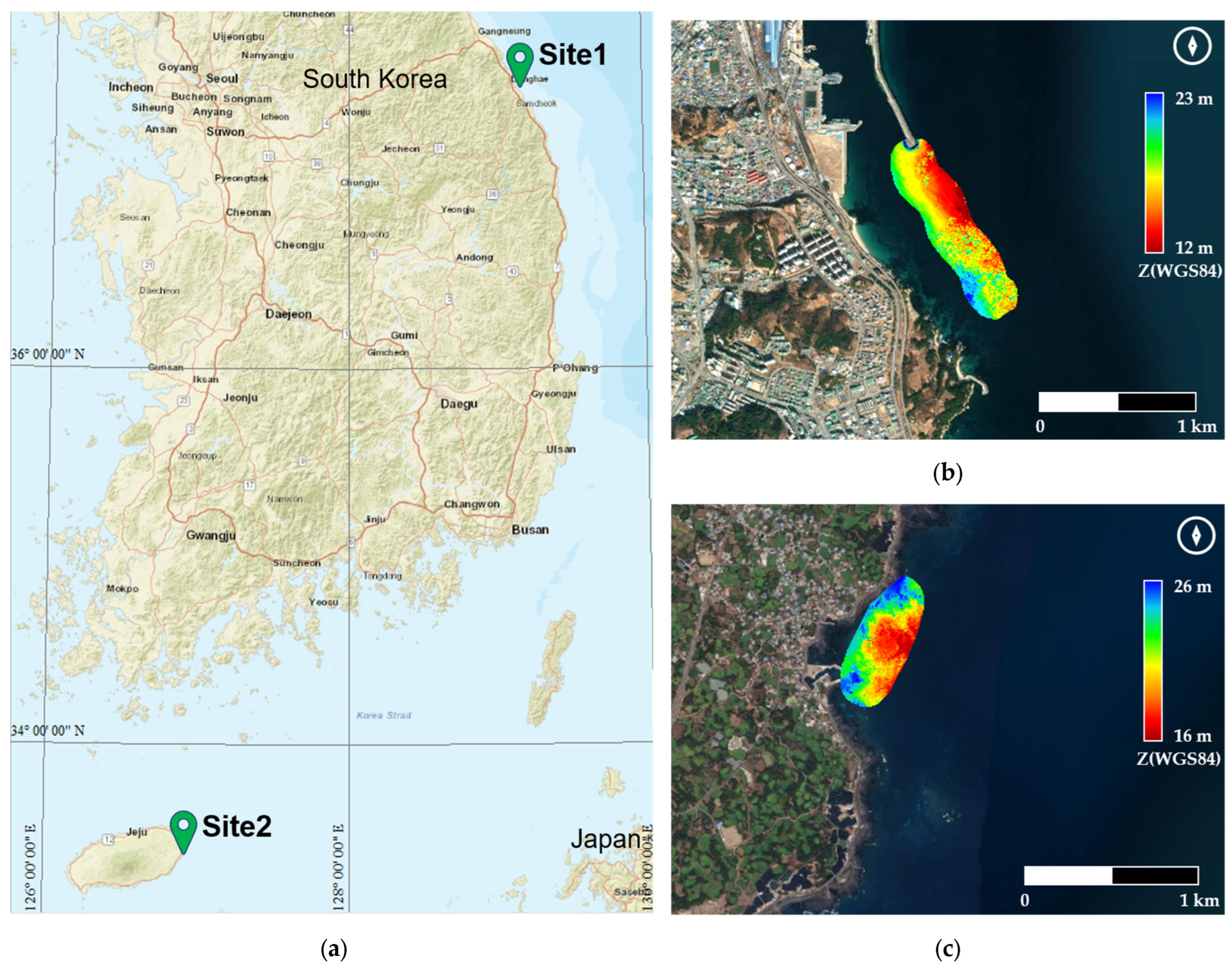
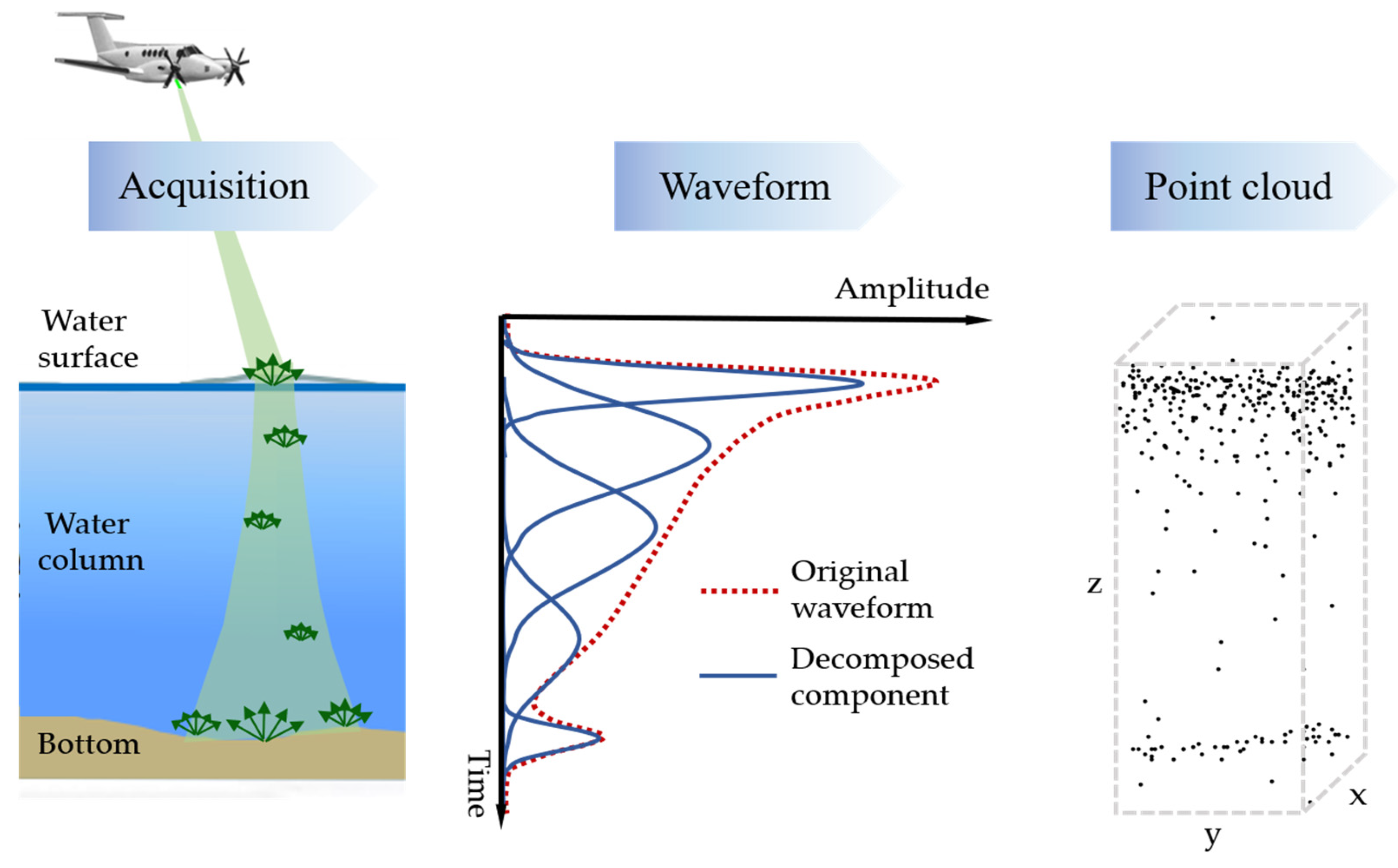
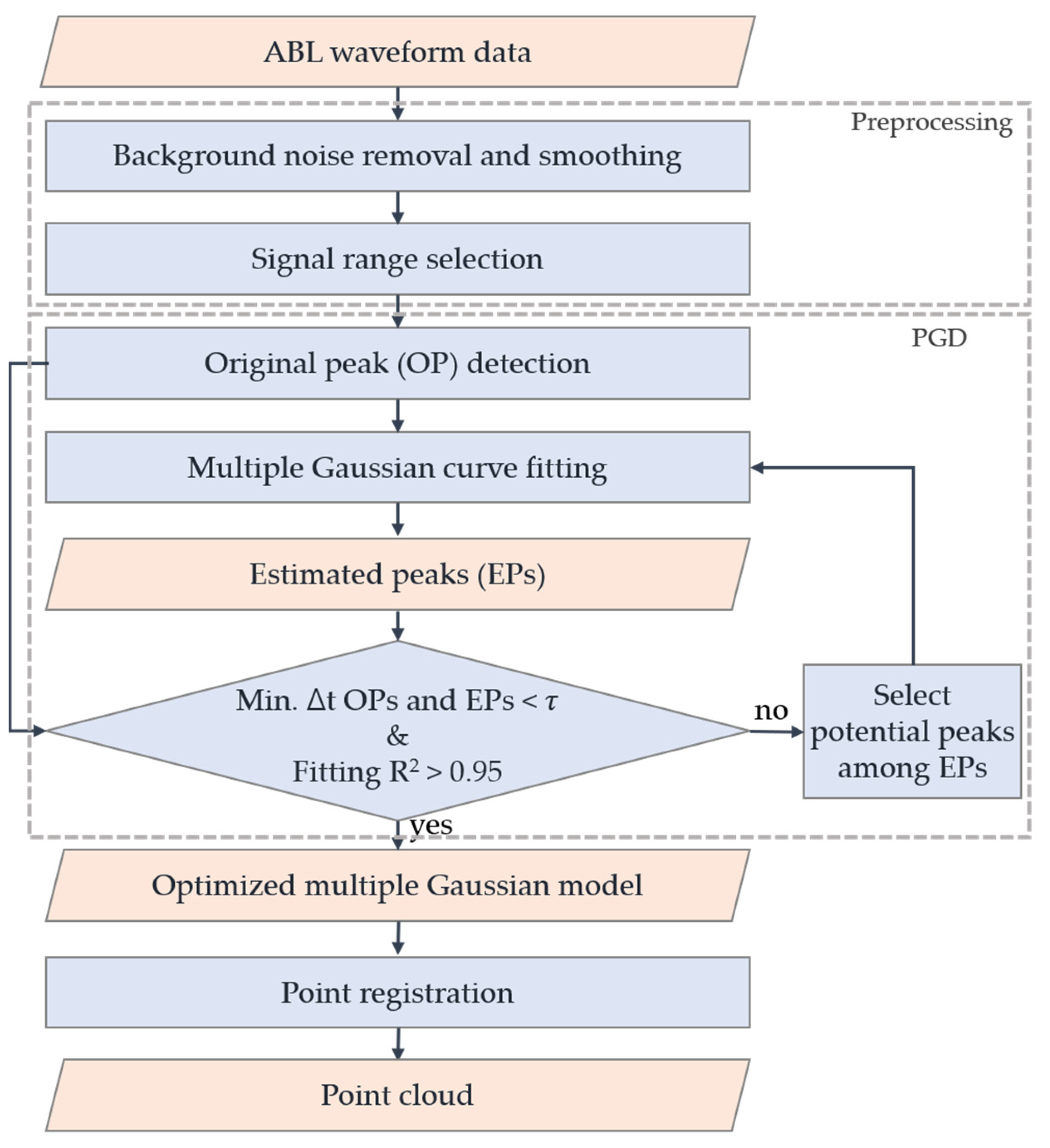
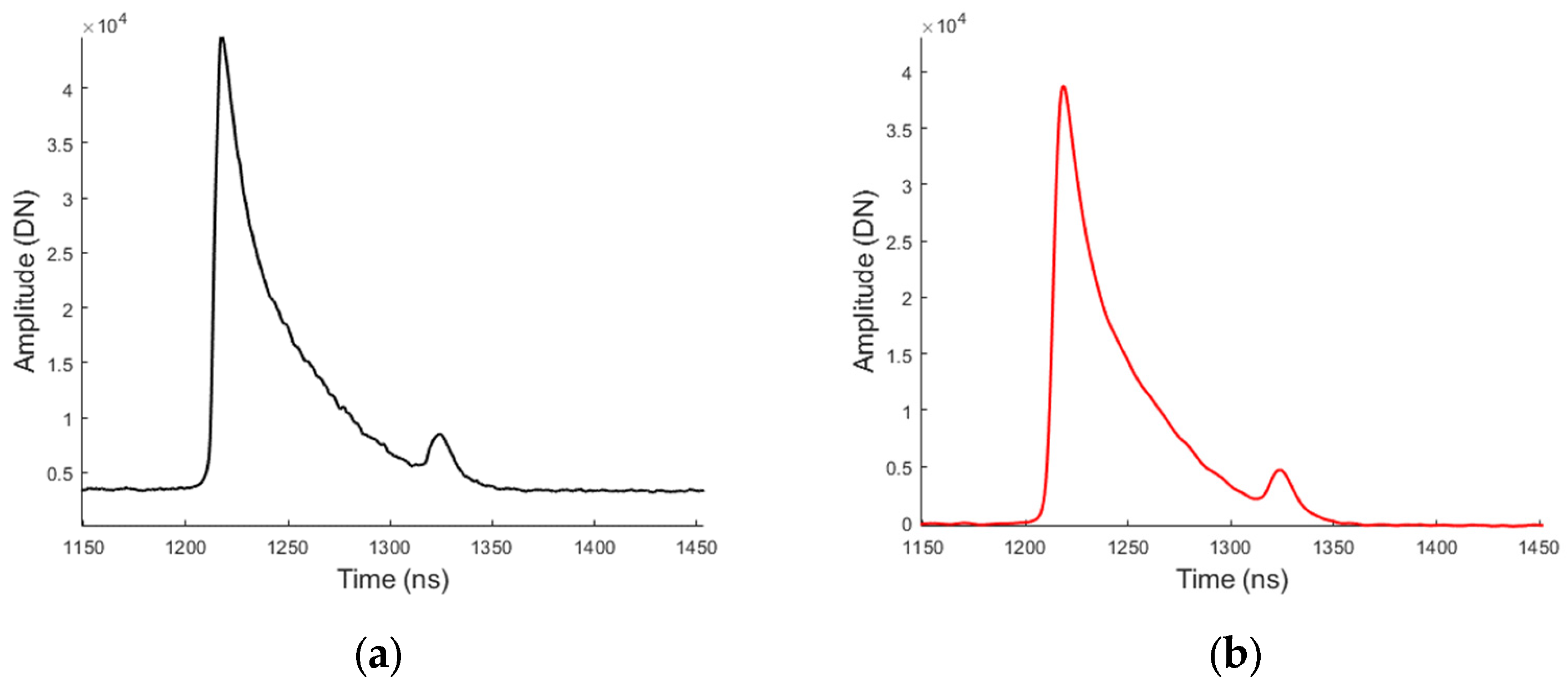
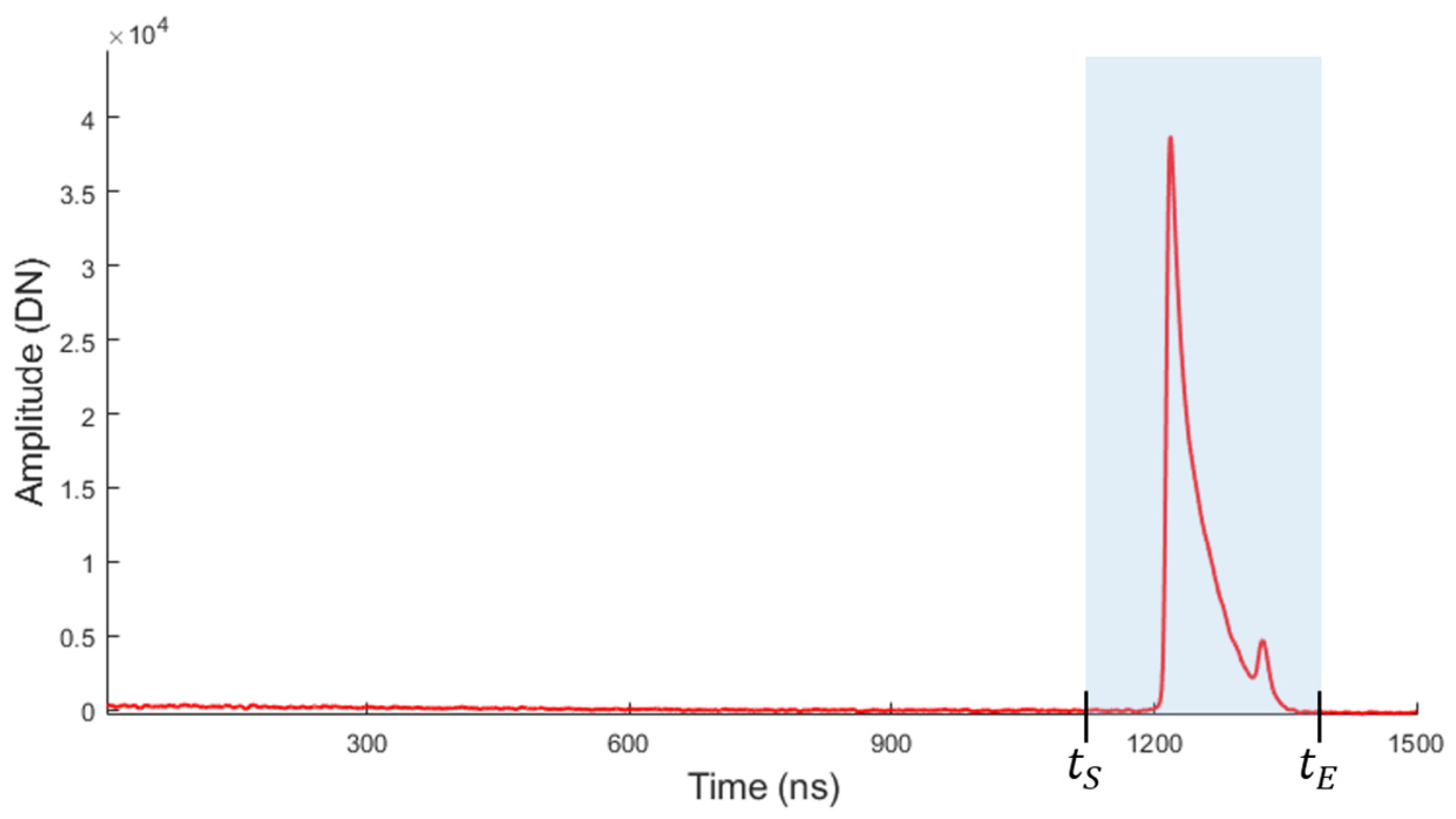

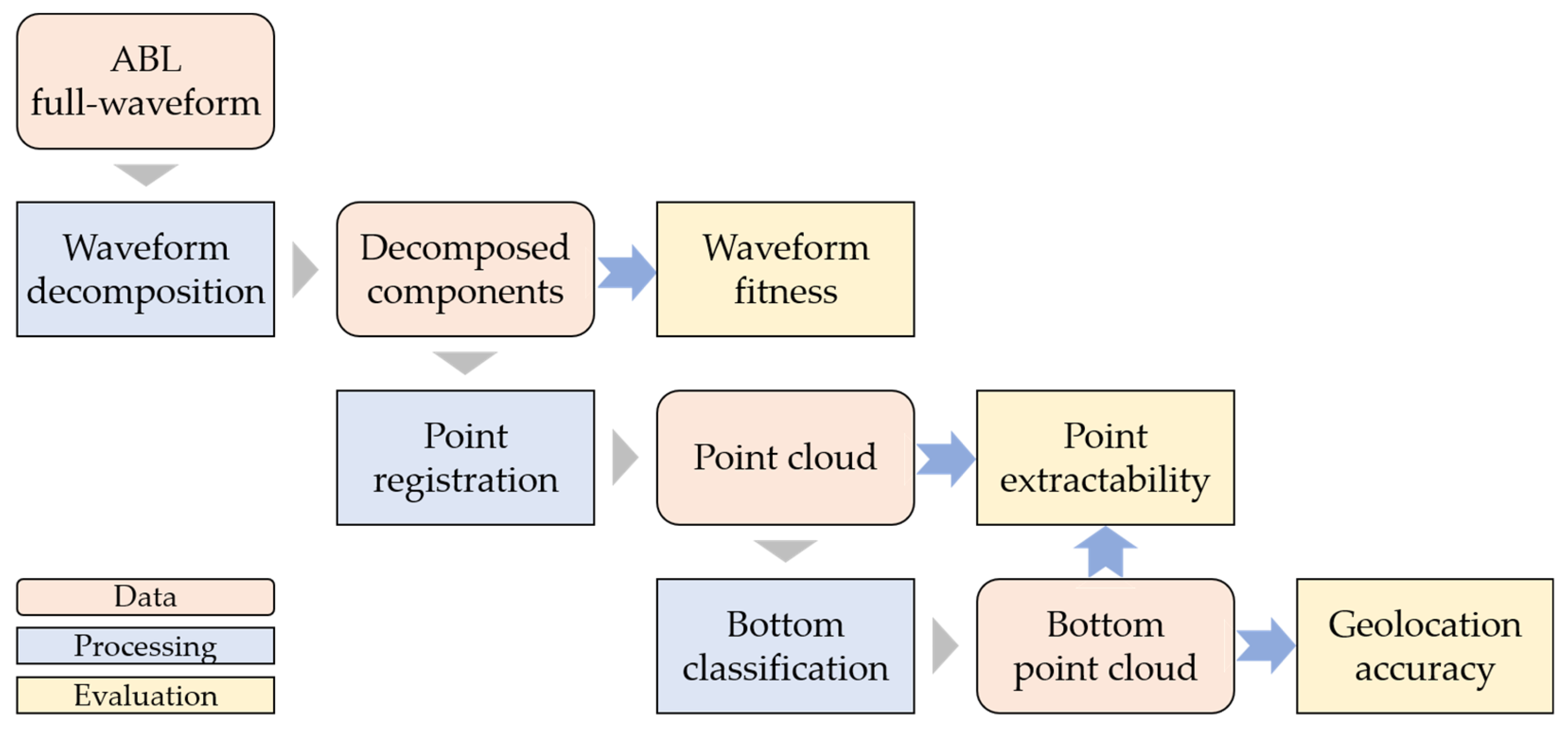
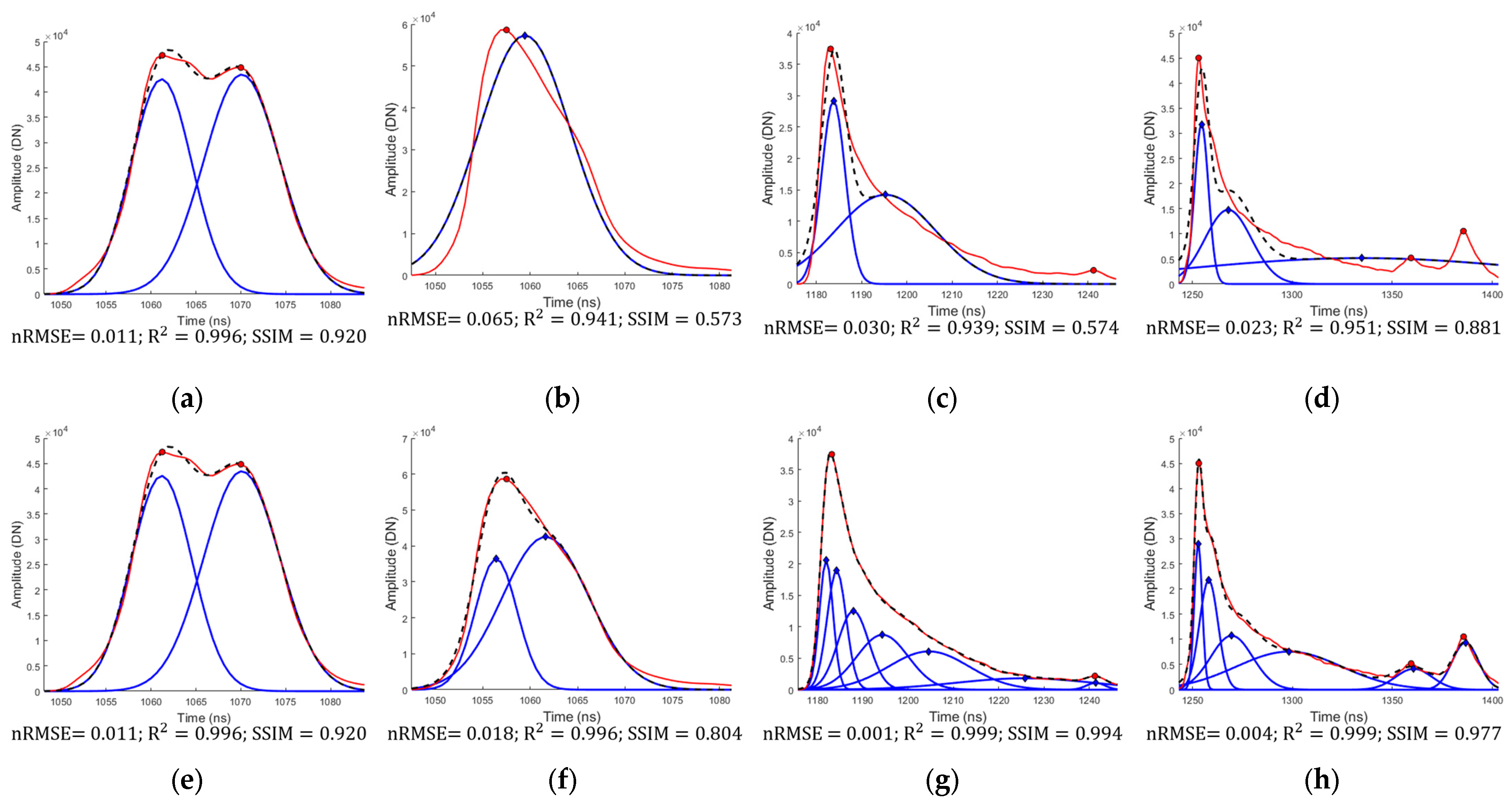
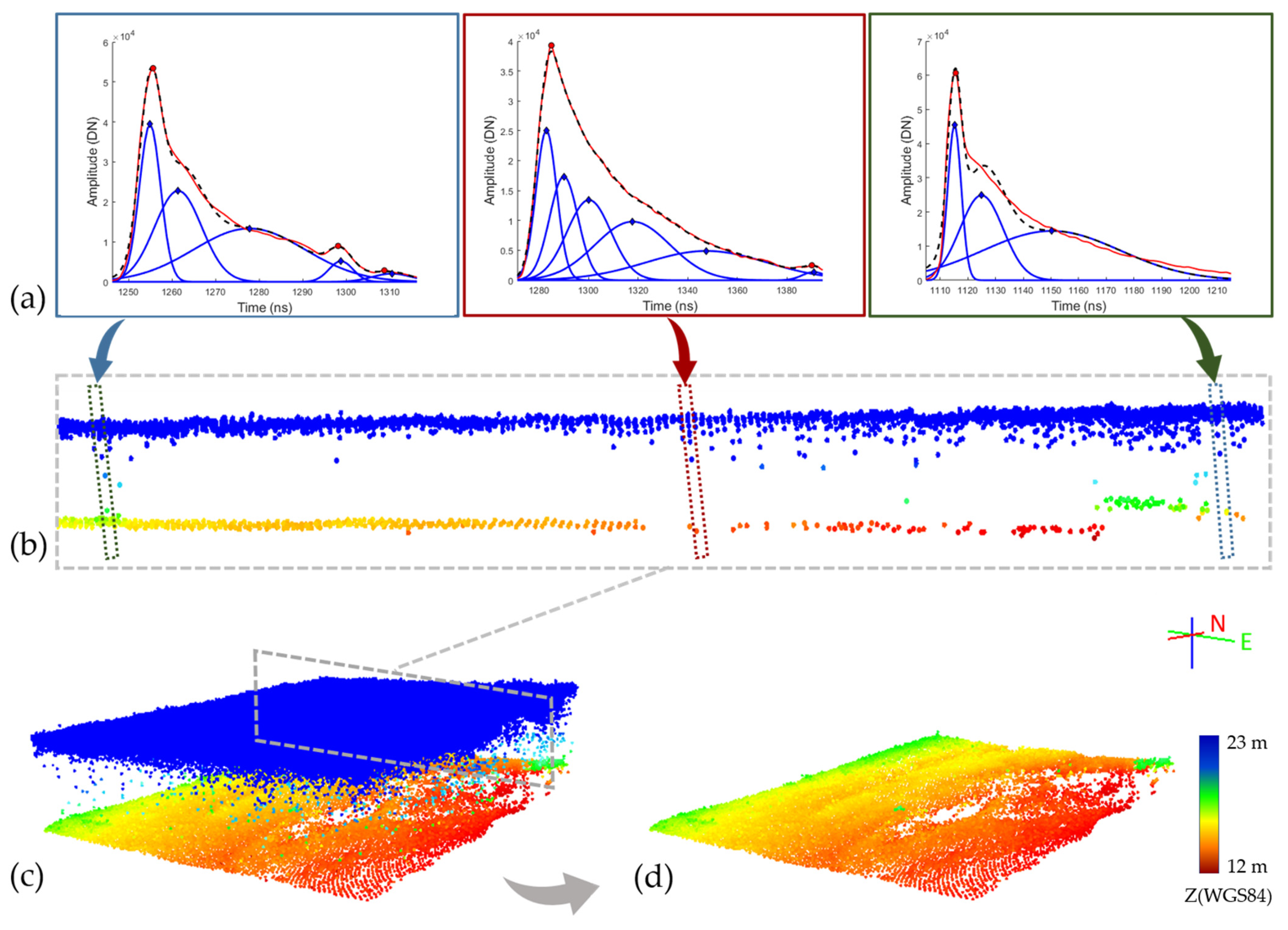
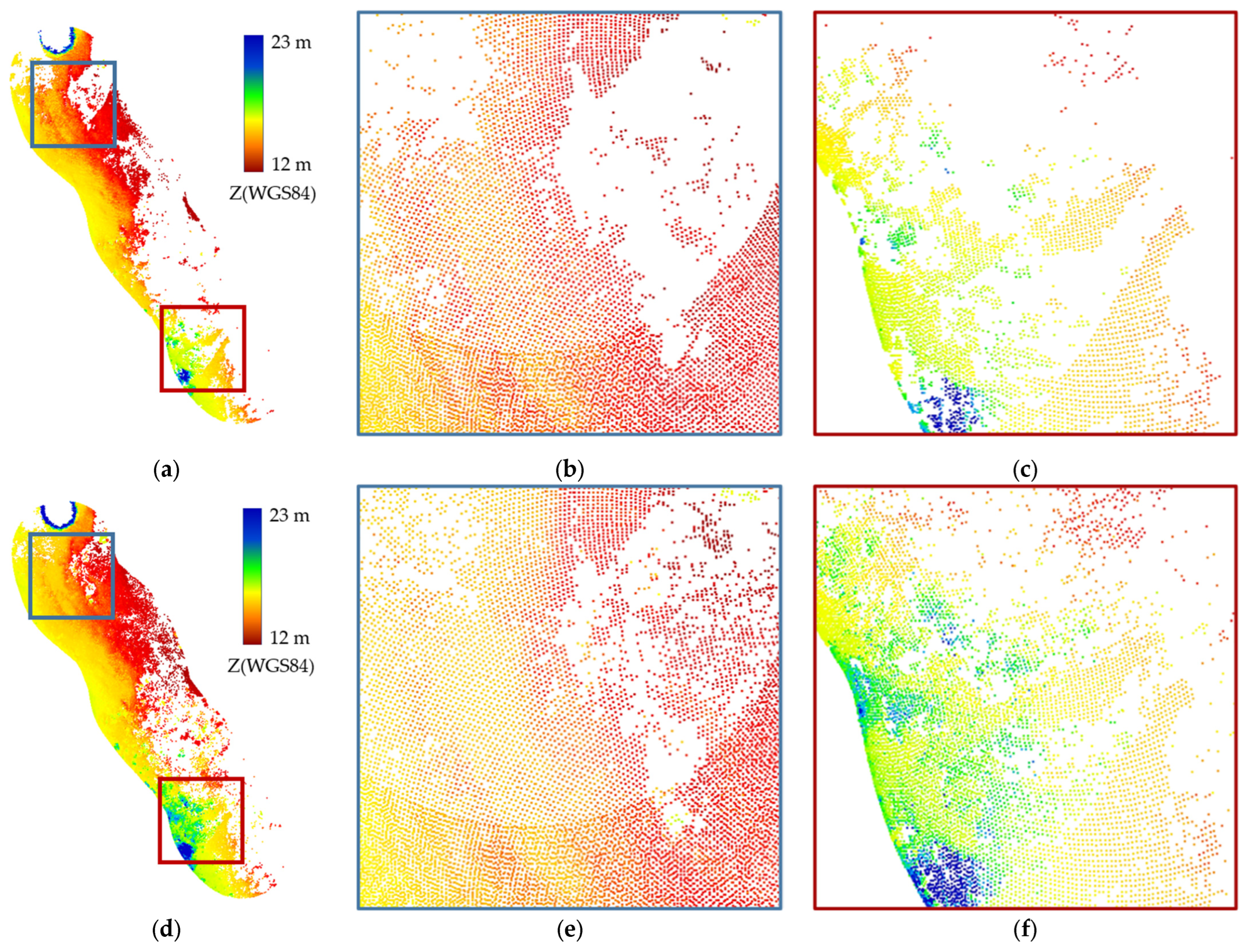
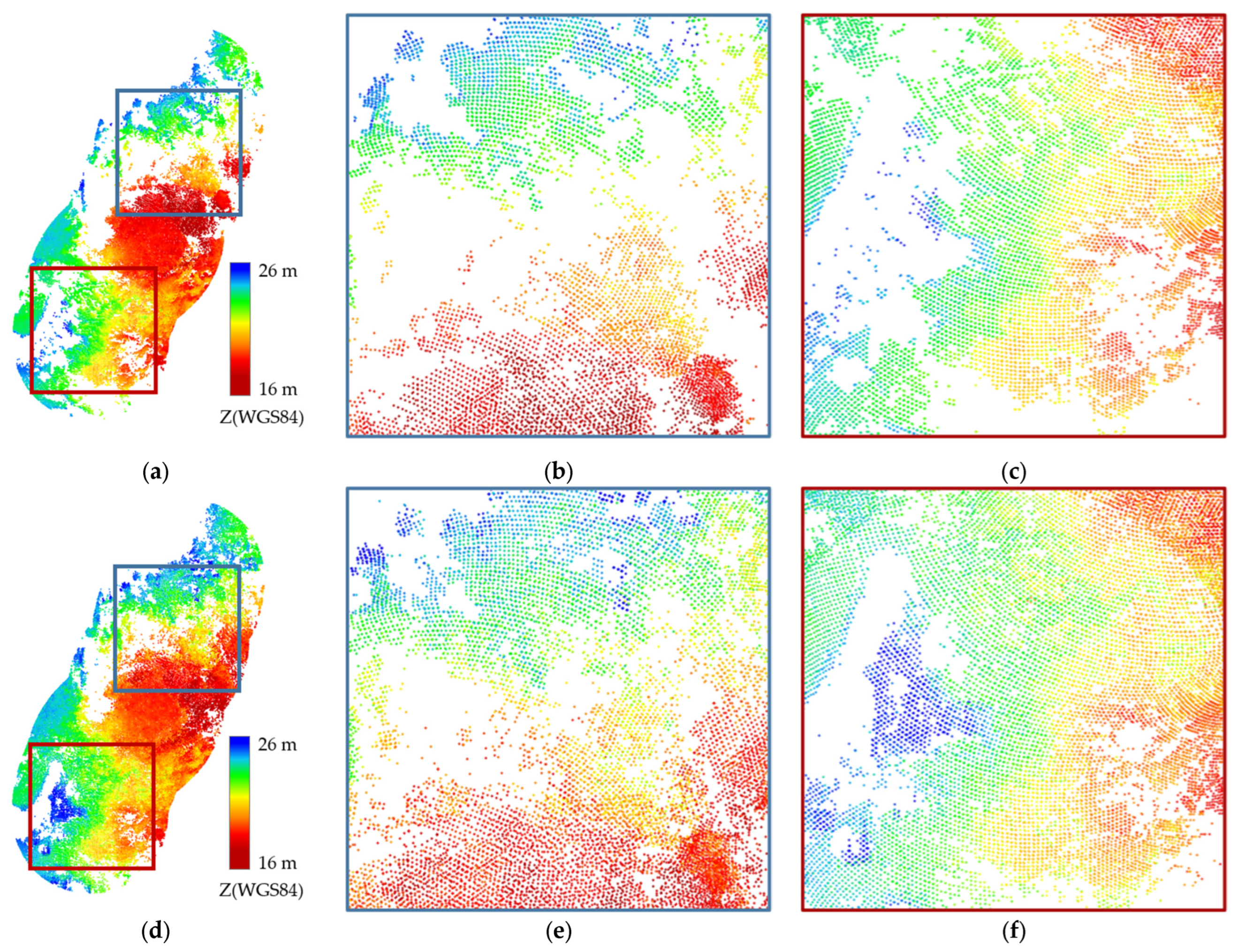
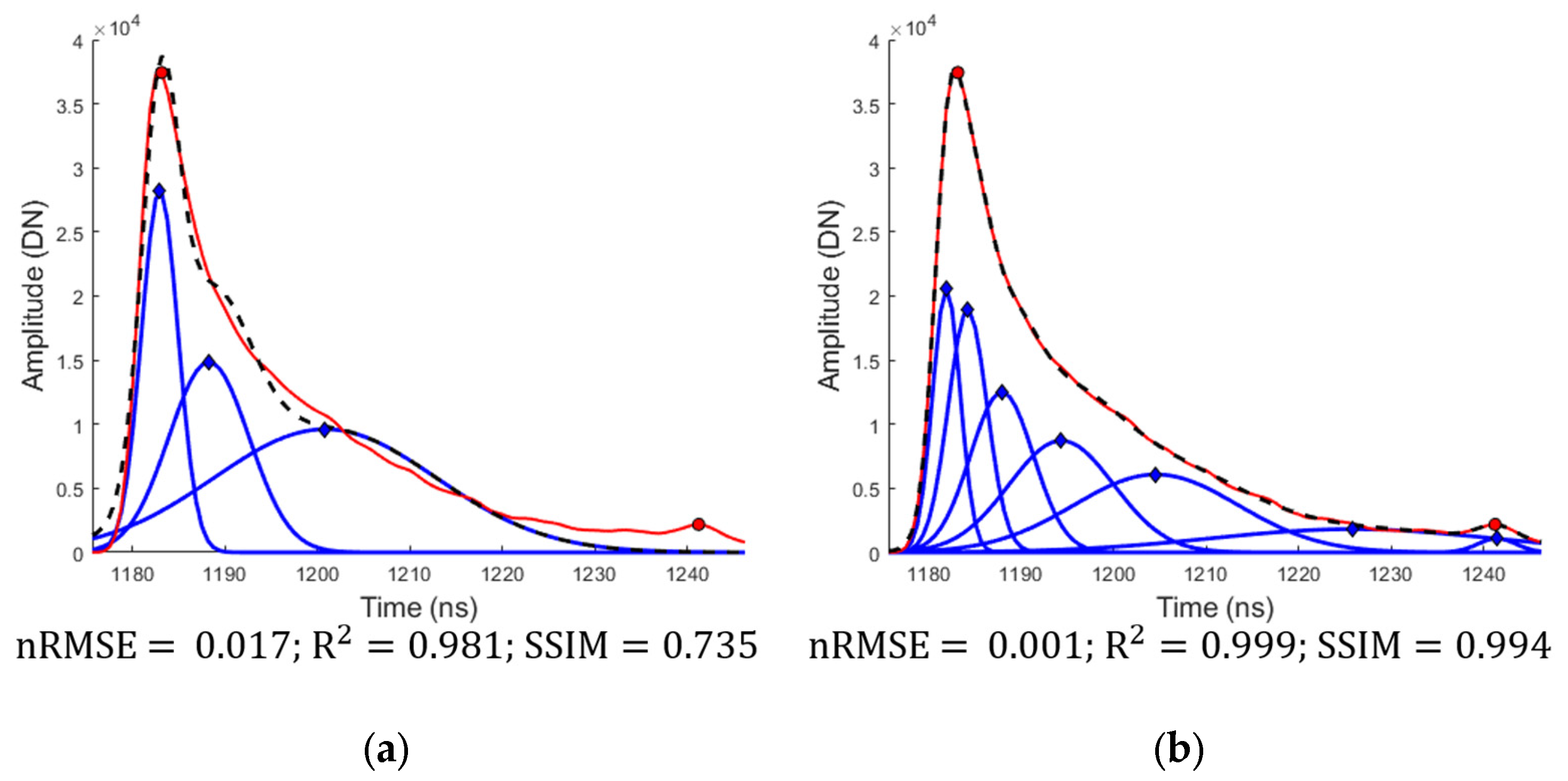
| Parameter | Specifications | |
|---|---|---|
| Sensor | Laser wavelength | 532 nm (green) 1064 nm (NIR) |
| Laser beam divergence | 7 mrad (green) 10.5 mrad (NIR) | |
| Laser pulse width | 1.7 ns | |
| Scan method | Rotating prisms | |
| Field of view | 20° | |
| Pulse repetition rate | 10 kHz | |
| Operation | Operating flight altitude | 400 m |
| Swath width | Flying altitude at 70% | |
| Aircraft speed | 140 kts | |
| Minimum range (1.5 Secchi depth) | 10 m |
| Location | Acquisition Date | Area (m2) | Depth Range (m) | Number of Waveforms | |
|---|---|---|---|---|---|
| Site 1 | Donghae, Republic of Korea | 22 March 2022 | 381,392 | 5–16 | 286,720 |
| Site 2 | Jeju Island, Republic of Korea | 28 March 2022 | 215,152 | 0–9.5 | 143,360 |
| Method | Normalized RMSE | R2 | SSIM | |
|---|---|---|---|---|
| Site 1 | CGD | 0.0635 ± 0.0302 | 0.709 ± 0.140 | 0.535 ± 0.184 |
| PGD | 0.0179 ± 0.0114 | 0.978 ± 0.019 | 0.907 ± 0.055 | |
| Site 2 | CGD | 0.0759 ± 0.0363 | 0.808 ± 0.142 | 0.695 ± 0.183 |
| PGD | 0.0260 ± 0.0183 | 0.980 ± 0.023 | 0.901 ± 0.072 |
| Method | Total Point Cloud | Bottom Point Cloud | |||
|---|---|---|---|---|---|
| Number of Points | Point Density (pts/m2) | Number of Points | Point Density (pts/m2) | ||
| Site 1 | LBASSD | 430,376 | 1.128 | 64,581 | 0.169 |
| PGD | 979,283 | 2.568 | 76,336 | 0.200 | |
| Site 2 | LBASSD | 412,760 | 1.918 | 63,156 | 0.294 |
| PGD | 545,020 | 2.533 | 71,945 | 0.334 | |
| Method | ∆Z Error (m) | |
|---|---|---|
| Site 1 | LBASSD | −0.684 ± 0.395 |
| PGD | −0.315 ± 0.427 | |
| Site 2 | LBASSD | 0.033 ± 0.457 |
| PGD | 0.109 ± 0.501 |
Disclaimer/Publisher’s Note: The statements, opinions and data contained in all publications are solely those of the individual author(s) and contributor(s) and not of MDPI and/or the editor(s). MDPI and/or the editor(s) disclaim responsibility for any injury to people or property resulting from any ideas, methods, instructions or products referred to in the content. |
© 2023 by the authors. Licensee MDPI, Basel, Switzerland. This article is an open access article distributed under the terms and conditions of the Creative Commons Attribution (CC BY) license (https://creativecommons.org/licenses/by/4.0/).
Share and Cite
Kim, H.; Jung, M.; Lee, J.; Wie, G. Progressive Gaussian Decomposition of Airborne Bathymetric LiDAR Waveform for Improving Seafloor Point Extraction. Appl. Sci. 2023, 13, 10939. https://doi.org/10.3390/app131910939
Kim H, Jung M, Lee J, Wie G. Progressive Gaussian Decomposition of Airborne Bathymetric LiDAR Waveform for Improving Seafloor Point Extraction. Applied Sciences. 2023; 13(19):10939. https://doi.org/10.3390/app131910939
Chicago/Turabian StyleKim, Hyejin, Minyoung Jung, Jaebin Lee, and Gwangjae Wie. 2023. "Progressive Gaussian Decomposition of Airborne Bathymetric LiDAR Waveform for Improving Seafloor Point Extraction" Applied Sciences 13, no. 19: 10939. https://doi.org/10.3390/app131910939
APA StyleKim, H., Jung, M., Lee, J., & Wie, G. (2023). Progressive Gaussian Decomposition of Airborne Bathymetric LiDAR Waveform for Improving Seafloor Point Extraction. Applied Sciences, 13(19), 10939. https://doi.org/10.3390/app131910939






